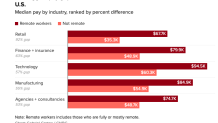
Remote workers are out-earning their in-office peers in several industries including tech and finance, according to new research from Payscale.
The findings corroborate other research that shows that people who work from home earn more. Remote workers are twice as likely to earn above the median pay for non-remote workers in the same industry and zip code, a study from payroll provider Gusto found last fall.
They're earning an average $8,553, or 9.7%, more a year than their in-office counterparts, according to a recent analysis of 30 "remote-capable" jobs by Ringover, a cloud-based telecom provider.
For their report, Payscale surveyed over 300,000 working U.S. adults between August 2021 and August 2023, defining "remote" as anyone who telecommutes most or all of the time.
Get South Florida local news, weather forecasts and entertainment stories to your inbox. Sign up for NBC South Florida newsletters.
Retail and customer service has the widest pay gap between remote and non-remote workers of all industries, Payscale reports, followed by finance and insurance, with tech and manufacturing a close third and fourth.

But these pay gaps don't signify discrimination, says Ruth Thomas, a pay equity strategist at Payscale.
Money Report
Instead, the pay discrepancies between remote and non-remote employees suggest that companies with return-to-office mandates are losing their higher-paid employees and restricting remote opportunities to more senior, specialized roles.
Seventy-two percent of companies that reduced their remote work offerings say they lost valuable employees as a result, according to a recent ZipRecruiter survey of more than 2,000 U.S. employers.
On the flip side, companies that offer remote jobs are attracting more candidates, with remote jobs getting more than three times as many applications as similar in-person jobs on ZipRecruiter.
Most of those jobs, however, are reserved for experienced, senior talent: On FlexJobs, for example, entry-level jobs make up less than 6% of hybrid and remote listings.
Thomas points to a few factors that could explain the wage gap. Remote workers have lower overhead costs and access to a wider pool of potential employers, which could translate to larger take-home pay.
Plus, those who work from home tend to be experienced professionals who are further along in their careers, which gives them more leverage to negotiate flexible work arrangements, she says.
While most organizations (86%) say they have not changed their methodology for paying remote workers since the start of the pandemic, per Payscale's research, Thomas says creating transparent, equitable pay strategies between remote and non-remote employees in similar roles can help bridge the wage gap.
Some companies might decide to pay remote employees the same as in-office workers, no matter where they live, while others opt to set compensation based on the market value of an employee's skills and experience, instead of their location.
For any approach to be effective, Thomas adds, the program must be flexible and open to employee feedback.
"We're still seeing organizations really settle into whatever work arrangement works best for them, and then they will work out the pay structures behind that," says Thomas. "But the longer they wait to figure that out, the more talent they risk losing."
DON'T MISS: Want to be smarter and more successful with your money, work & life? Sign up for our new newsletter!
As technology reshapes business expectations, some leaders are embracing change and transforming their organizations for the future. Join the CNBC Evolve Global Summit on November 2 to hear strategies to adapt, innovate and succeed in this new era of business. Buy your ticket here.
Check out:






